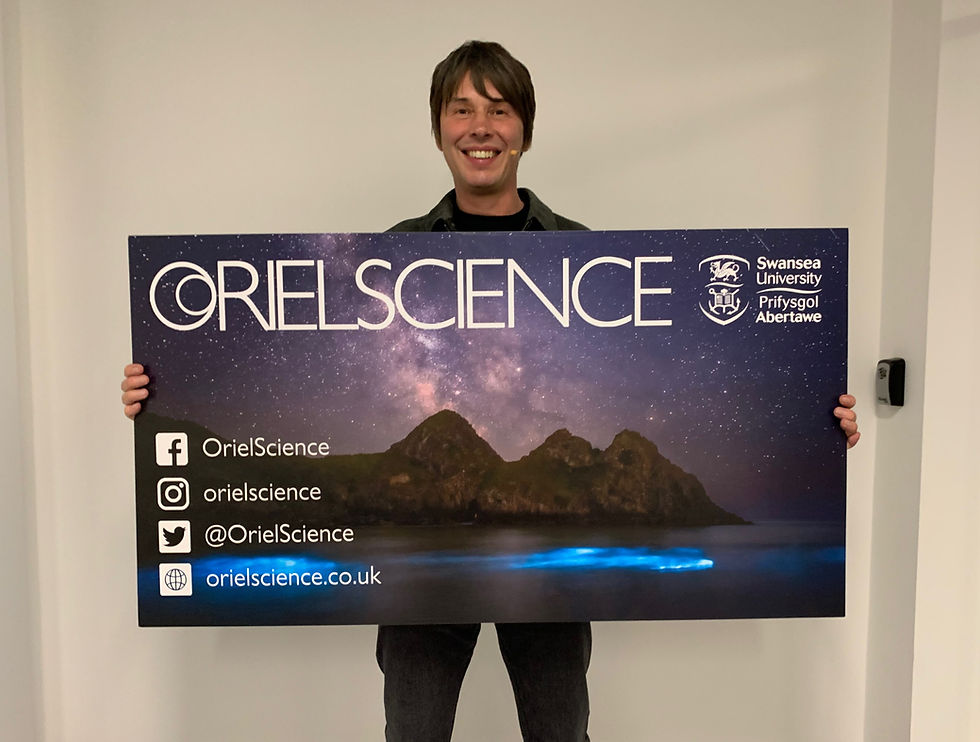Oriel Science's Social Prescribing Project
- orielscience
- Mar 27, 2024
- 3 min read
Updated: Mar 28, 2024
For the past ten weeks, Oriel Science has been hosting social prescribing events to aid the rehabilitation of brain injury patients. These activities are designed to promote collaboration, education and social connection. This project was a collaboration between Dr Jessica Fletcher, Deputy-Director of Oriel Science and Dr Zoe Fisher of the Swansea Bay University Health Board Regional Neuropsychology and Community Brain Injury Service. Social prescribing is a way to personalise patients’ healthcare, addressing their social and emotional needs by providing group activities that differ from standard healthcare such as surfing, cooking, and educational workshops.
Most of the sessions were related to one of Oriel Science’s Imaging Exhibits, with the researchers connected to the exhibit coming in each week to give an in-depth talk about their work. These topics covered a wide range including archaeology, physics, biology, technology and more.
Week 1
Introduction week! Our participants were introduced to Oriel Science and give an overview of the project.
Week 2
On Monday 22nd January, the Oriel Science team ran a guided tour around our medical exhibits by Dr Jessica Fletcher. We hosted some hands-on experiments to discuss how chemicals react with one another and how this is used in the production of household items.
Week 3
Dr Sophie Shermer led a talk on brainwaves and how brain activity is measured. Among the many topics covered during the session were the different types of brain waves and how we could ‘train’ our brain through techniques such as meditation to promote wellbeing. The group then tried the NeuroSky EEG headset that monitors brain activity and uses it to control an app on your phone.
Week 4

‘Deep fakes’ is a phrase that is cropping up everywhere as the world of AI develops rapidly. Professor Yvonne McDremott Rees ran a session on what a deep fake is, and how it is being used in modern society. The session was followed by a discussion about the advantages and dangers of a technology shrouded in such controversy.
Week 5
Physicist and Oriel Science Project Director, Professor Chris Allton, took the group on a mind-bending journey to describe the physics behind time. Of course, this included our participants being time itself, using a variety of props including a “black hole” gym ball and a ticking clock. Why sit and learn about time, when you can be it?
Week 6
Have you ever noticed there are universal symbols used across all languages? You could likely find the airport taxi rank no matter where you landed in the world. Dr Irene Reppa led an intriguing session on Global Visual Language, demonstrating how important icons and images are to human communication and tested how well some symbols already in use can be understood.
Week 7

Dr Jessica Fletcher ran a hands-on activity for our participants to don their coats and get in the lab. The session explored how blood types are determined in a clinical setting, then our participants were then able to work in their simulated blood lab to process this “blood” for themselves.
Week 8
Oriel Science’s Deputy-Director, astronomer Dr Sarah Roberts, ran our popular Stardust Hunters workshop. This workshop explains the different kinds of meteorites and how they sometimes end up on Earth. Using dust gathered from outside using a magnet and plastic bag, the group observed this under a microscope to determine whether any dust from space had been collected.
Week 9
It is well known that our environment can affect our physical and mental health. Because of this, there is a whole science around how to build neighbourhoods that benefit us. Rebecca Pedrick-Case led the session designed with Dr Amy Mizen to explore how our participants would design their own ‘perfect’ neighbourhood.
Week 10
The researcher for our final session was Dr Ersin Hussein who presented the participants with just some of the history of Ancient Cyprus and the relevant artefacts currently displayed at the Egypt Centre. They were presented with different images of an artefact in the collection and discussed how this affects symbolism and functionality. They could then draw or make their own version of the artefact. Towards the end of the session, they discussed whether this process affected their feelings toward the object.
We are saddened to say goodbye to our social prescribing group after an incredible few months of community outreach. Due to its popularity, we are hoping to host more social prescribing sessions in the future.








Comments